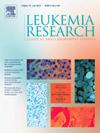New treatments for adult T-cell leukemia/lymphoma
IF 2.1
4区 医学
Q3 HEMATOLOGY
引用次数: 0
Abstract
Adult T cell leukemia lymphoma (ATL) is a mature T cell neoplasm caused by human T-cell lymphotropic virus type 1 (HTLV-1). ATL is endemic in specific geographic regions of the world closely related to areas with high prevalence of HLTV-1 infection, including Southwestern Japan, the Caribbean Basin, Central Africa, South America, Northern and Central Australia. HLTV-1 is primarily transmitted through breastmilk in asymptomatic carriers with a long latency period before transformation into ATL in 3 – 5 % of carriers after acquisition of multiple leukemogenic mutations. The Shimoyama classification established by the Japanese Lymphoma Study Group more than three decades ago remains clinically relevant and practical for guiding treatment. Due to the rarity of this illness, prospective, large prospective clinical are challenging to perform and treatment recommendations are based upon limited evidence. Aggressive disease subtypes have median survival ranging in months and the only curative therapy remains achieving deep remission with induction therapy followed by consolidative allogeneic transplantation. The prognosis for relapsed disease remains dismal due to chemo-refractoriness and limited therapeutic options. Herein, we review the current landscape of novel therapeutic agents with a focus on relapsed and refractory ATL including their mechanisms of action, resistance, and clinical efficacy.
成人t细胞白血病/淋巴瘤的新疗法。
成人T细胞白血病淋巴瘤(ATL)是一种由人T细胞嗜淋巴病毒1型(HTLV-1)引起的成熟T细胞肿瘤。ATL在世界上与HLTV-1感染高发地区密切相关的特定地理区域流行,包括日本西南部、加勒比盆地、中非、南美洲、澳大利亚北部和中部。HLTV-1主要在无症状携带者中通过母乳传播,在3 - 5% %的携带者获得多重白血病基因突变后转化为ATL之前有很长的潜伏期。三十多年前由日本淋巴瘤研究小组建立的Shimoyama分类仍然具有临床相关性和指导治疗的实用性。由于这种疾病的罕见性,前瞻性,大型前瞻性临床研究具有挑战性,治疗建议基于有限的证据。侵袭性疾病亚型的中位生存期为数月,唯一的治愈性治疗仍然是通过诱导治疗和巩固同种异体移植实现深度缓解。由于化疗难治性和有限的治疗选择,复发疾病的预后仍然令人沮丧。在此,我们回顾了目前的新治疗药物的前景,重点是复发性和难治性ATL,包括它们的作用机制、耐药性和临床疗效。
本文章由计算机程序翻译,如有差异,请以英文原文为准。
求助全文
约1分钟内获得全文
求助全文
来源期刊

Leukemia research
医学-血液学
CiteScore
4.00
自引率
3.70%
发文量
259
审稿时长
1 months
期刊介绍:
Leukemia Research an international journal which brings comprehensive and current information to all health care professionals involved in basic and applied clinical research in hematological malignancies. The editors encourage the submission of articles relevant to hematological malignancies. The Journal scope includes reporting studies of cellular and molecular biology, genetics, immunology, epidemiology, clinical evaluation, and therapy of these diseases.
 求助内容:
求助内容: 应助结果提醒方式:
应助结果提醒方式:


